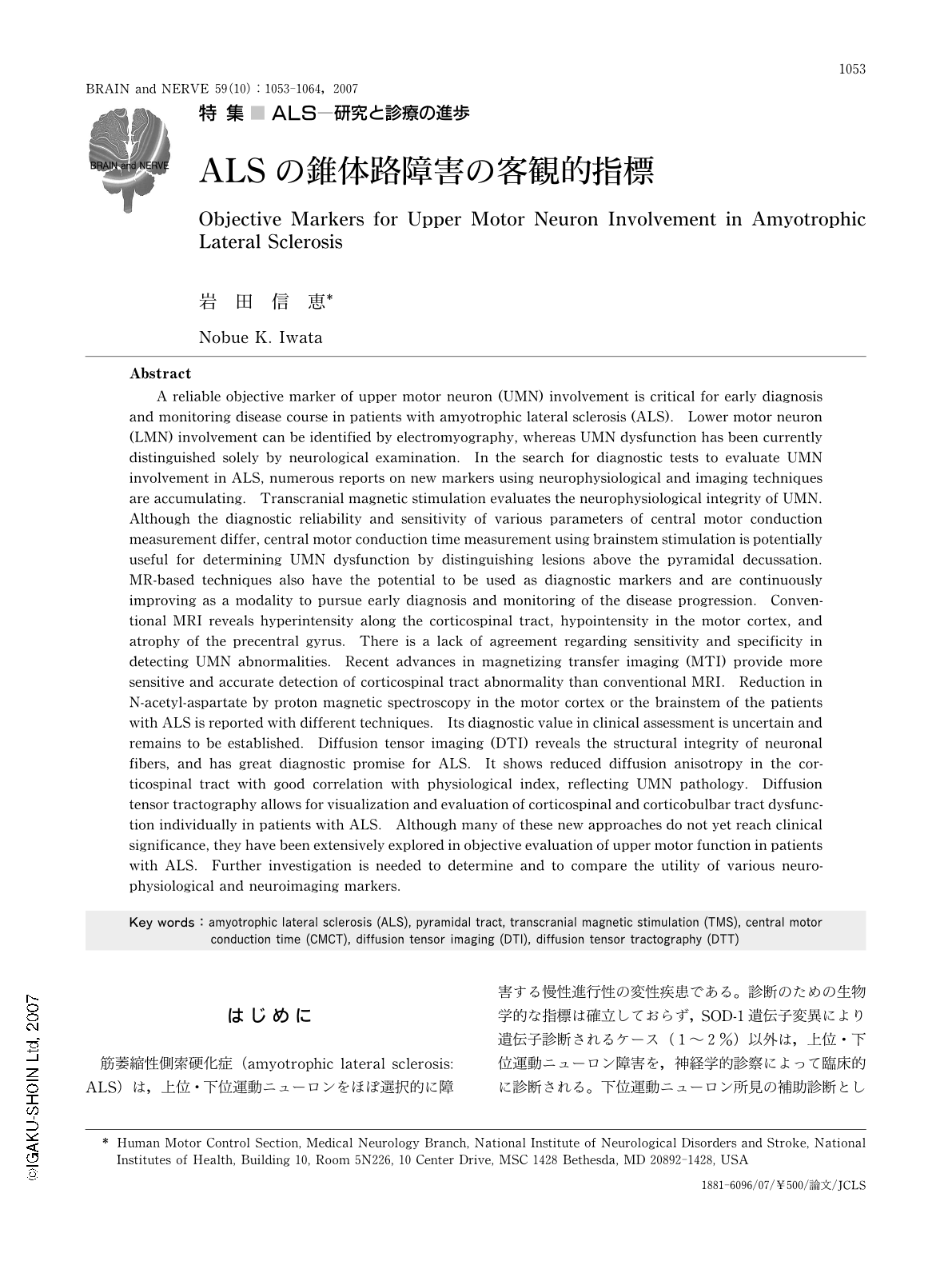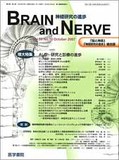Japanese
English
- 有料閲覧
- Abstract 文献概要
- 1ページ目 Look Inside
- 参考文献 Reference
はじめに
筋萎縮性側索硬化症(amyotrophic lateral sclerosis: ALS)は,上位・下位運動ニューロンをほぼ選択的に障害する慢性進行性の変性疾患である。診断のための生物学的な指標は確立しておらず,SOD-1遺伝子変異により遺伝子診断されるケース(1~2%)以外は,上位・下位運動ニューロン障害を,神経学的診察によって臨床的に診断される。下位運動ニューロン所見の補助診断としては,本特集他項にもあるように針筋電図が汎用され,臨床的に障害が明らかでない部位の下位運動ニューロン所見を,客観的に評価する手段として確立されている。El Escorial診断基準においても,1998年の改定により臨床所見に加えて筋電図の脱神経所見を診断基準に加え,clinically probable-laboratory-supported ALSがprobable ALS群に加えられた1)。
さて,上位運動ニューロン所見,すなわち錐体路障害についても,生理学的に,また神経画像的に検討がなされている。残念ながら下位運動ニューロン障害における針筋電図所見のように,診断基準の一部として確立した手法はないのが現状である。ALS患者には,病初期に下位運動ニューロンの所見が前景に出て臨床的な錐体路障害を欠くもの,下位ニューロンの障害が強いため上位ニューロンの障害がマスクされて臨床的診断が困難なケースも存在し,このようなケースでは上位運動ニューロンの補助診断手段があれば,早期の診断に寄与しうる。また,進行性筋萎縮症と臨床診断された患者の剖検で,50~75%に皮質脊髄路の障害を認めたとの報告があり2),下位運動ニューロンの障害が顕著な場合,上位運動ニューロン障害の臨床診断が困難であることを示している。ALSの早期診断は,病像が完成してしまう以前の治療的介入,治療効果の評価のみならず,患者の予後を明らかにして不安を軽減し,残された人生の計画を立て,不要なドクターショッピングを抑止することなどにより,患者のQOLを高める意味でも重要である。ALSの診断・治療において錐体路障害をできうる限り早期に,臨床的に診断されるより早い段階で客観的に診断し,定量的に経時評価しうる指標は有用と考えられる。
ALSの錐体路機能を客観的に評価する試みは数多く報告されているものの,まだ臨床的に利用される段階とは言えない。本稿においては,こうした試みの中で今後臨床応用の可能性が期待されるもののいくつかについて,筆者の経験を含めて紹介する。磁気刺激を用いた中枢運動伝導路の評価,神経画像検査を用いた評価,特に拡散テンソル画像を用いて臨床所見との相関を調べた評価法について概説する。
なお,錐体路という語は,厳密には大脳皮質運動野の皮質第5層にある錐体細胞より始まる運動下行路で,脊髄前角細胞または運動性脳神経核へシナプスする前までの,皮質脊髄路(corticospinal tract),皮質延髄路(corticobulbar tract)を含む伝導路を指すが,ここでは起始皮質の運動野も含めた上位運動ニューロン機能を含めて述べる。
Abstract
A reliable objective marker of upper motor neuron (UMN) involvement is critical for early diagnosis and monitoring disease course in patients with amyotrophic lateral sclerosis (ALS). Lower motor neuron (LMN) involvement can be identified by electromyography, whereas UMN dysfunction has been currently distinguished solely by neurological examination. In the search for diagnostic tests to evaluate UMN involvement in ALS, numerous reports on new markers using neurophysiological and imaging techniques are accumulating. Transcranial magnetic stimulation evaluates the neurophysiological integrity of UMN. Although the diagnostic reliability and sensitivity of various parameters of central motor conduction measurement differ, central motor conduction time measurement using brainstem stimulation is potentially useful for determining UMN dysfunction by distinguishing lesions above the pyramidal decussation. MR-based techniques also have the potential to be used as diagnostic markers and are continuously improving as a modality to pursue early diagnosis and monitoring of the disease progression. Conventional MRI reveals hyperintensity along the corticospinal tract, hypointensity in the motor cortex, and atrophy of the precentral gyrus. There is a lack of agreement regarding sensitivity and specificity in detecting UMN abnormalities. Recent advances in magnetizing transfer imaging (MTI) provide more sensitive and accurate detection of corticospinal tract abnormality than conventional MRI. Reduction in N-acetyl-aspartate by proton magnetic spectroscopy in the motor cortex or the brainstem of the patients with ALS is reported with different techniques. Its diagnostic value in clinical assessment is uncertain and remains to be established. Diffusion tensor imaging (DTI) reveals the structural integrity of neuronal fibers, and has great diagnostic promise for ALS. It shows reduced diffusion anisotropy in the corticospinal tract with good correlation with physiological index, reflecting UMN pathology. Diffusion tensor tractography allows for visualization and evaluation of corticospinal and corticobulbar tract dysfunction individually in patients with ALS. Although many of these new approaches do not yet reach clinical significance, they have been extensively explored in objective evaluation of upper motor function in patients with ALS. Further investigation is needed to determine and to compare the utility of various neurophysiological and neuroimaging markers.

Copyright © 2007, Igaku-Shoin Ltd. All rights reserved.


